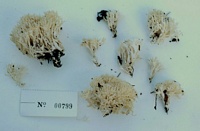|
 Scytinopogon pallescens Scytinopogon pallescens
SynonymsPterula pallescens
BiostatusPresent in region - Indigenous. Non endemic
Images (click to enlarge)
Owner: Ron Peterson |
Article: Petersen, R.H. (1988). The clavarioid fungi of New Zealand. New Zealand Department of Scientific and Industrial Research, Bulletin 236: 170 pp. Wellington:.
Description: Fruit bodies up to 4 x 4 cm, much-branched, white all over when young, slowly creamy ('light vinaceous buff') upward. Stipe (when discrete) short, white, smooth, flattened, lobed to lacunose in cross section, but usually obscure, with branching occurring from the base. Major branches several, flattened, occasionally reticulate, rebranching in 3-5 ranks. Branches flattened, irregular to sympodial; internodes irregular, hardly diminishing; axils rounded. Apices cristate when young, flattened-digitate in age. Flesh of lower and middle portions white when fresh, cartilaginous and pliable when dry. Odour of sweet chloride of lime; taste negligible.
Surface hyphae of lower parts 1.5-3.5 µm diam., thin-walled, gnarled, clamped, free, loosely
interwoven. Tramal hyphae of lower and middle parts identical, with granular interhyphal material and strictly parallel orientation; gloeoplerous hyphae undifferentiated, occurring as indeterminate lengths of refringent hyphae, occasional. Subhymenium not extensive; hyphae 1.5-2 µm diam., thin-walled, clamped, strictly parallel. Hymenium thickening; basidia 20-30 x 55 µm, subcylindrical to narrowly clavate, clamped, hyaline; contents minutely granular; sterigmata 4, up to 4 um long, spindly. Spores about 4.5-5.2 x 3.4-3.8 µm, nodulose-lobed, with lobes often cuspidate; contents usually uniguttulate; hilar appendix conical, not prominent.
Habitat: Gregarious under Agathis.
Notes: Use of Comers's (1970; p.87) key leads the reader to Scytinopogon dealbatus (Berk.) Corner, but examination of the type of that epithet shows its spores to be ellipsoid and echinulate, rather than angular-noduloseas described by Corner. I accept (Petersen 1984) Clavaria dealbata as a species of Ramariopsis, not very dissimilar to R. kunzei.
According to Corner (1970), both Scytinopogon robustus (Rick) Corner and S. echinosporus (Berk. & Br.) Corner show inflation of tramal hyphae. I have examined the type of some synonymous epithets under S. echinosporus (specifically those of Clavaria implexa Lév. and C. umbrina Lév.) and find their spores to be ellipsoid and ornamented with molar-shaped warts, but not nearly as irregular in shape as those of the collection cited below.
Finally, the type specimen of Clavaria (Scytinopogon) angulispora Pat. represents a Clavulina (probably Clavulina connata Corner), so the epithet angulispora must be removed from Scytinopogon. I am left, therefore, with the name S. pallescens (Bres.) Corner, the type of the genus, which I use here only because Corner has listed it as synonymous with his concept (non vera) of S. angulispora. This is a poor reason, and the present collection may represent a new taxon.
|